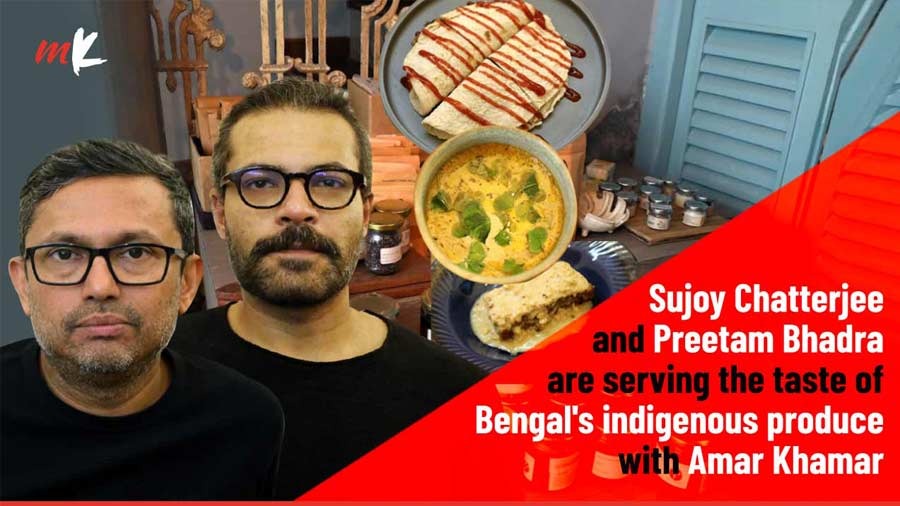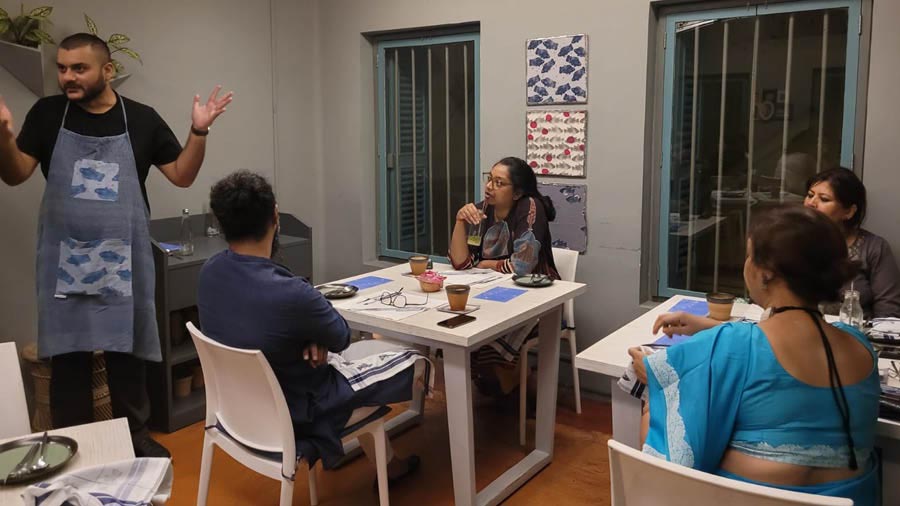From a little storefront in Kolkata’s Dhakuria, Amar Khamar has been bringing little-known and popular organic produce from the farms of Bengal to the tables in Kolkata. Established in 2019, the online and offline store, which has a new branch at Hindustan Road, champions indigenous produce, especially the many varieties of Bengal’s rice — many of which find their way to the menus of noted eateries like Sienna Cafe.
One of the unique aspects of Amar Khamar is its tasting menu experience — the Amar Khamar Table. At Annaja, the new hideout on Hindustan Road, the winter edition laid out a seven-course menu featuring Bengal’s favourite produce of the season — food that hits the right chords of nostalgia. Using innovative techniques and taking inspiration from global cuisine, Amar Khamar’s winter table brought the techniques of stem-to-root cooking of Bengali cuisine in a farm-to-table meal.
My Kolkata joined six other guests at one of the Sunday luncheons at Annaja, which began with glasses of in-house fermented ginger soda. Here’s what you can look forward to at the winter edit of the Amar Khamar Table, which will be on till winter lasts.
Pora (first course)

Begun pora with shorshe-posto and red bell pepper sauce
The seven-course menu of the winter edit began with the familiar begun pora. The staple from Bengali kitchens was given a facelift with a tender, perfectly charred whole desi brinjal topped with a tangy combination of shorshe-posto and red bell pepper sauce. The guests enjoyed the brinjal till the last bit on the stem.
Argha Chatterjee, a resident of New Town and a regular at Amar Khamar, said, “This is not my first time at an Amar Khamar Table. I have been here for the pop-up held in March 2023. They do some excellent stuff with the ingredients. This begun was excellent. I am eager to see what’s next!”
Bhaja (second course)
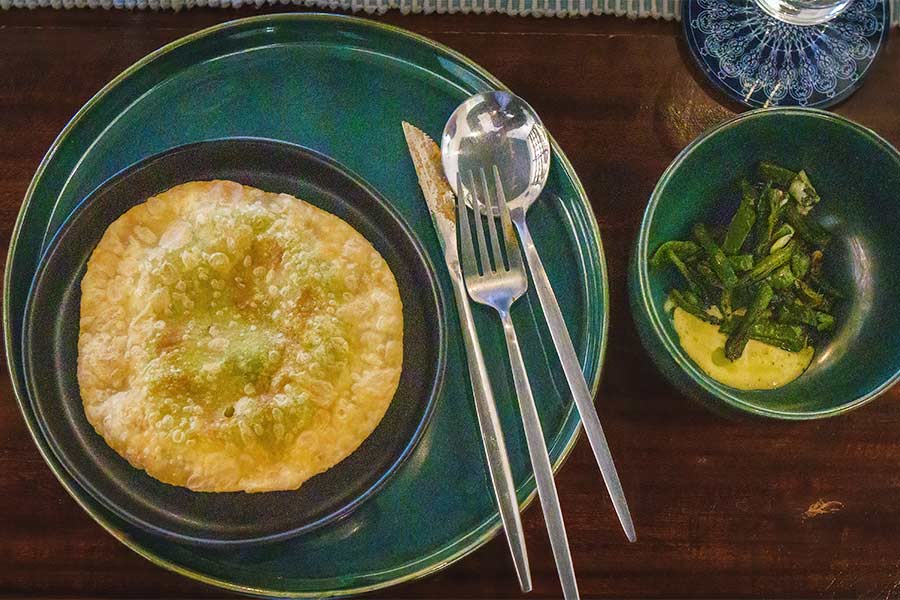
Koraishutir Kochuri with sheem bhaja and coconut cream
A Bengali’s all-time favourite — kochuri torkari — featured in the second course. Koraishutir kochuri, the quintessential winter delicacy, was served with the unusual side of sheem (flat beans) bhaja paired with a coconut cream. The combination of kochuri and sheem surprised the guests, but the smiles at the end told of a winning combination.
For Enakshi Dhar, an IT professional from Bengaluru, this was the first experience of the Amar Khamar Table and she found the second course “amazing”. “The flavours were so prominent, yet subtle. I have heard that the dessert is usually very unique. I am excited to see what we are served!”
Oyako-bungalow (third course)

The third course was inspired by Japanese oyakodon, a rice-bowl dish with chicken and eggs, and the Bengali Dak Bungalow Chicken, the Oyako-bungalow has steamed Kanakchur rice flavoured with gundruk — fermented greens popularly eaten in Nepal and Darjeeling — served on a bed of generously seasoned chicken and potato salad and topped with a sunny egg yolk cured in in-house soya sauce. A garnish of crispy garlic chips elevated the flavour.
The idea behind the dish was to bring together Bengal’s Dak bungalow [chicken] and Japan’s oyakodon, explained the head of the kitchen, Bhadra. “Oyako in Japanese means ‘parent and child’, denoting chicken and egg. While our Dak Bungalow is also somewhat the same where chicken and egg is cooked with potatoes.”
Ghonto (fourth course)
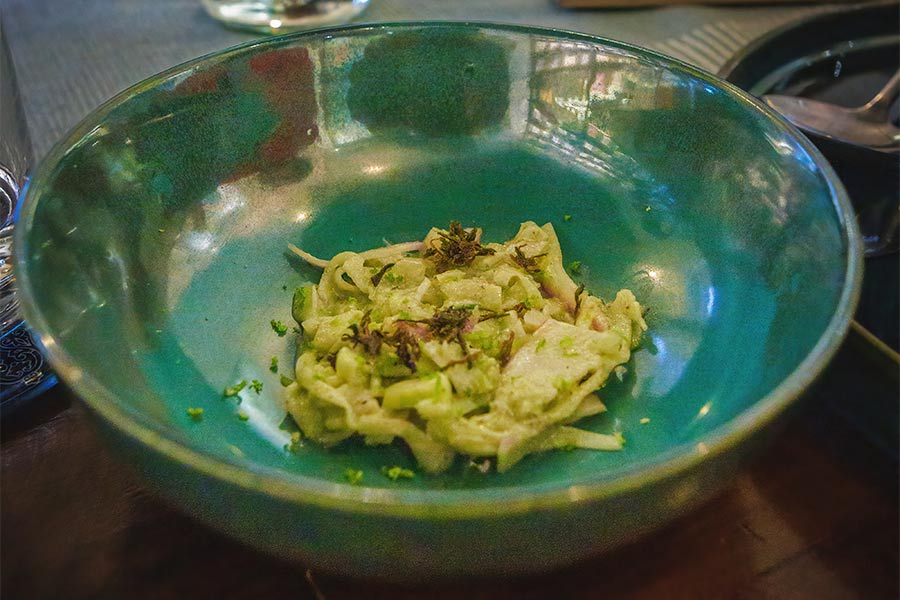
Mulor ghonto with geri gugli
Ghonto — a primarily vegetarian dish, sometimes made with the addition of fish or seafood, in which the vegetables are cooked until they are mushy — is an integral part of Bengali cuisine. The ghonto on the menu, made with radish, was another offbeat pick to include in a menu. The mulo ghonto was made with geri gugli (periwinkles or snails and clams) and seasoned with til (sesame) and jimbu. While geri gugli is a regional favourite, though not as popular anymore, jimbu is a herb from the onion family that’s popular in the Himalayan states of India and Nepal.
Sobji-Bhaat (fifth course)

The Sobji-Bhaat bowl was a take on the much-loved kimchi rice. Tulaipanji atap rice cooked with a kimchi made with mocha (banana flower). “This dish is inspired by the Korean rice bowl, therefore the mocha kimchi. We have used an in-house dressing, which is a reduction made with vegetable peel — again, a method to reduce waste,” Bhadra explained.
This dish sparked nostalgia for the guests, especially those who grew up in Bengali households, as they remember the homemade fried rice dishes their mothers or grandmothers would make. Like Enakshi Dhar said, “This bowl feels like home. Every bite has a surprise for you.”
Doodh-holud (sixth course)
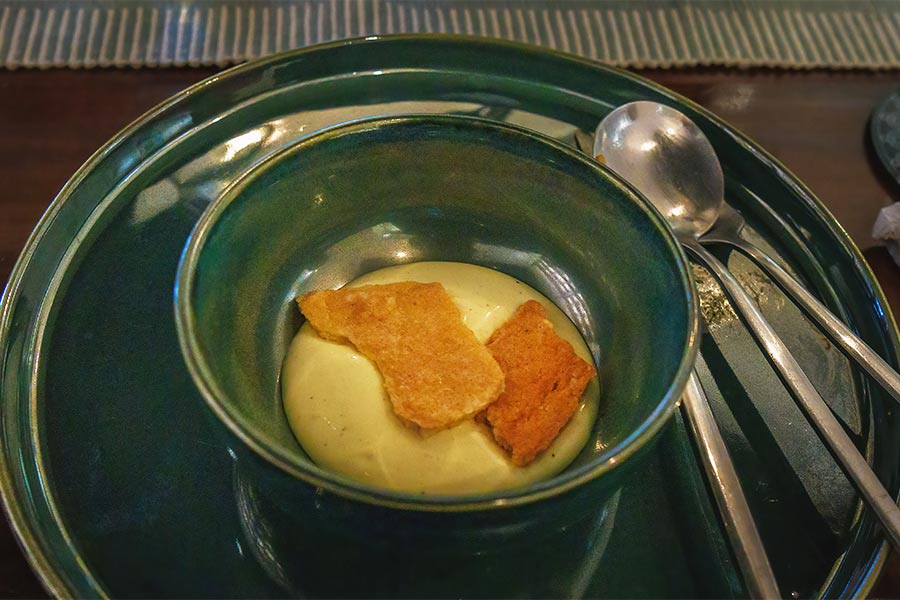
It was finally time for the most-awaited course — dessert! Haldi doodh, or doodh-holud in Bengali, is perhaps something most people remember from the winters of their childhood. A cup of warm milk flavoured with turmeric to keep away the chills or make you feel better when you have a cold.
The childhood nostalgia was put on a plate once more, with a turmeric and black pepper semifreddo, a creamy frozen dessert made with milk, sugar and eggs. It was topped with some toasty coconut sable — a tribute to the coconut cookies most of us have loved since childhood.
“We all remember doodh-holud from our childhood, especially during winters. We recreated that as a semifreddo,” said Bhadra introducing the star of the menu.
Cha-ta (seventh course)

A drink made with roasted Karpurkanti rice, with Binni rice chikki
A cuppa to end a big meal is always a delight. Concluding the meal, the last course was a take on the Bengali chaa aar ta — tea with accompaniments. A small bowl of warm and aromatic drink made with roasted fragrant Karpurkanti rice, served with a small chikki of Binni rice and jaggery sprinkled with a powder made from dehydrated tok dhyarosh (roselle).
“Binni is a sticky rice variant popular in Bangladesh. This has been used to make a chikki with jaggery,” the culinary head said.
The quaint and cosy Annaja

Amar Khamar’s second address at Hindustan Road, Annaja
Amar Khamar’s second address at Hindustan Road echoes the ethos of its store in Dhakuria, with one little addition. While the selection of organic ingredients are displayed on the shelves, there is a small selection of delectable food options you can try as you shop. The traditional and modern dishes are made using the produce, so you get a taste of the ingredients you’re buying. This culinary experience is provided to the consumers by Amar Khamar’s culinary head, Preetam Bhadra in collaboration with farmers-turned-cooks from Sunderbans.
“Local and seasonal produce is the hero in the culinary experience at Annaja. We want people to experience the ingredients, the aroma and flavours. At the kitchen, we are also focused on minimising waste,” explained Preetam Bhadra.
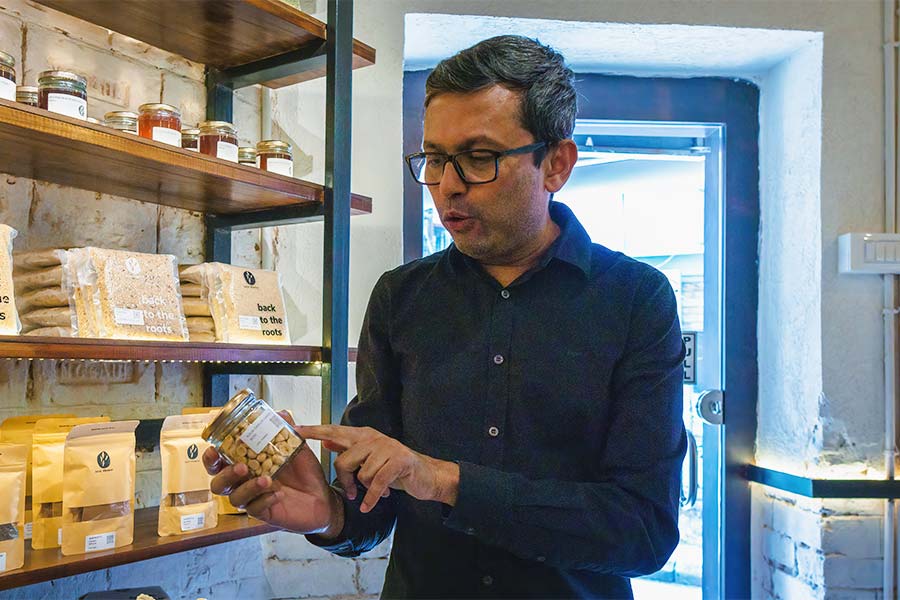
Founder Sujoy Chatterjee talks about an ingredient at Annaja
The regular menu at Annaja consists of some lip-smacking snacks, salads, sandwiches, desserts and beverages. Some of the highlights include duck sandwich, scotch eggs, the traditional Medinipuri sweet babarsa etc.
According to founder Sujoy Chatterjee, they intend for Annaja’s menu to be diverse, seasonal and focused on Bengali ingredients. “We are planning to focus on making Annaja our main branch where we provide both ingredients and food. The Dhakuria branch will be largely for providing ingredients to the consumers.”

The team at the Amar Khamar kitchen
Amar Khamar Table
The winter edit of the Amar Khamar table will be held every weekend till about the end of February. You can book your seat online. For a larger group (of 4-8 people), one can also request for a private table.
Address: 21B, Hindusthan Road, near Basanti Devi College, Gariahat
Pocket pinch: Rs 1,800 per person
Contact: 9330742283


